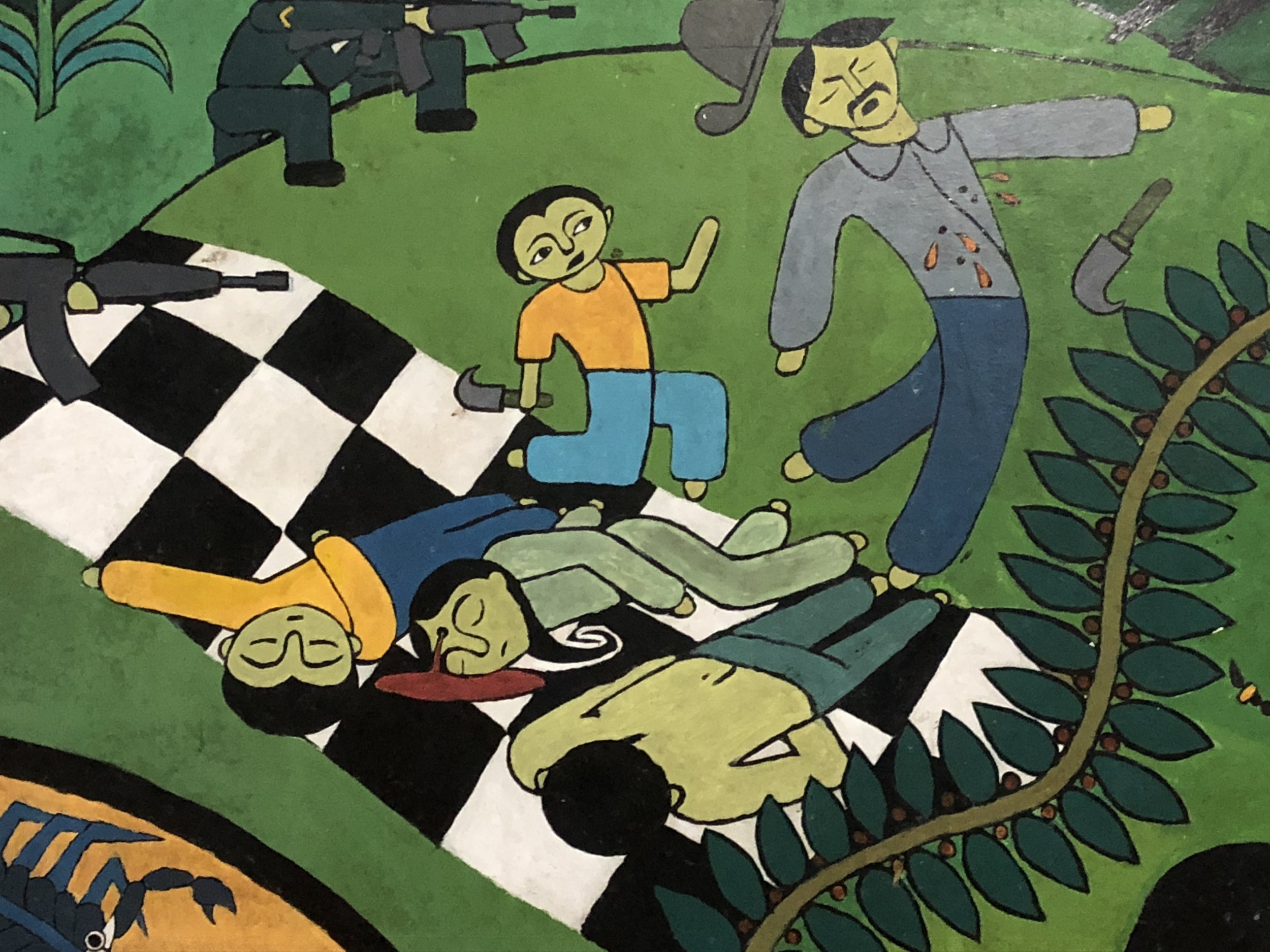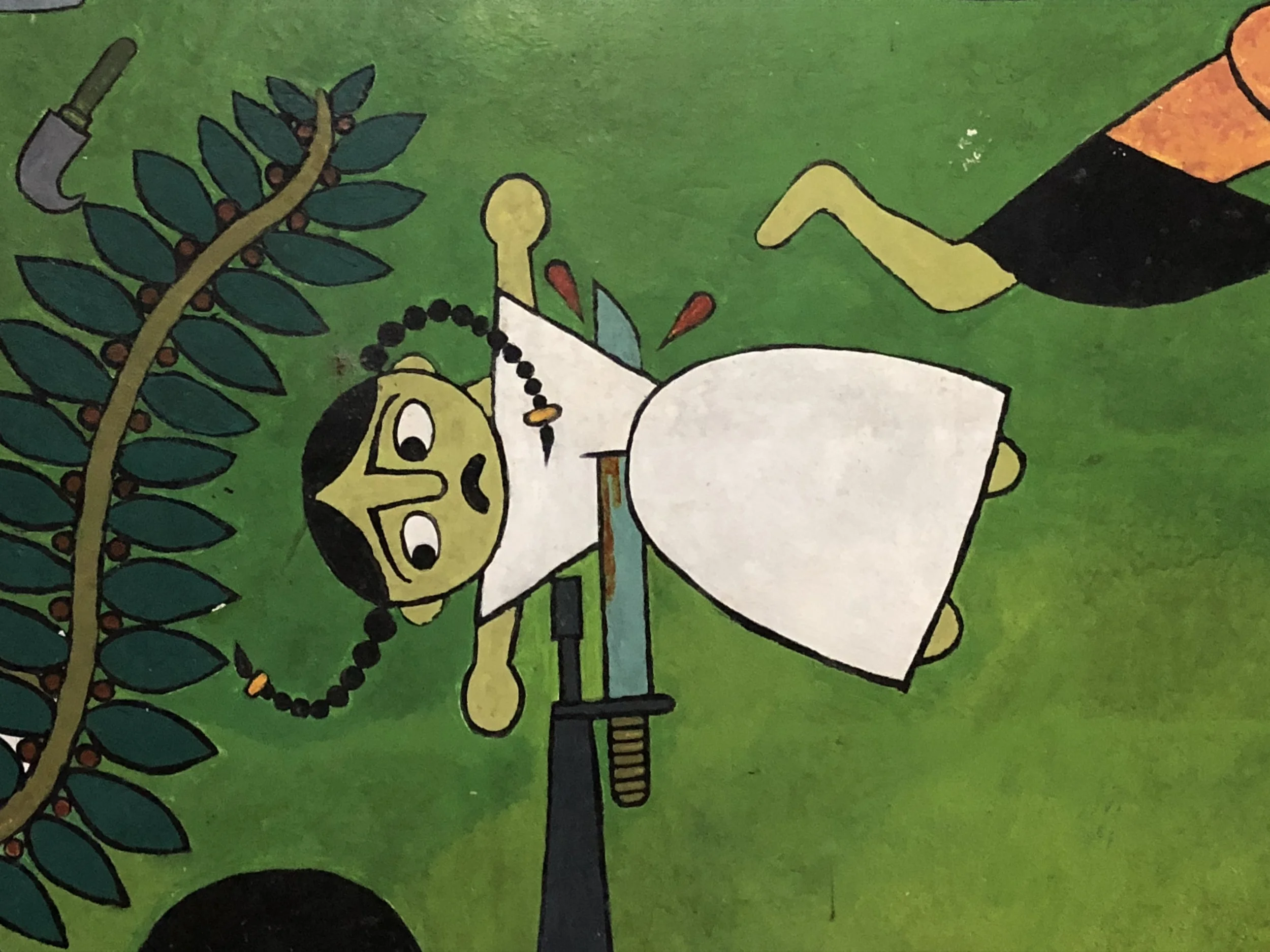Historical Background
On May 14, 1980, hundreds of people from different communities gathered in Las Aradas, a small village in the district of Yurique, located on the banks of the Sumpul River, near the border with Honduras. Las Aradas is part of the municipality of San José Ojos de Agua in the Department (province) of Chalatenango, El Salvador. The people gathered there to seek protection from violence because they faced daily persecution by the Salvadoran military, the national guard, and a paramilitary organization called ORDEN (Nationalist Democratic Organization).
Felipe, then a 25-year-old campesino, met with the other campesinos and campesinas who had arrived at Las Aradas the same day. Ana, aged 12, was also there with her mother and her 15-year old sister. So was Yanet, a 19-year old woman accompanied by her father and her baby. They had all taken refuge in Las Aradas because it was a historically demilitarized space. On previous occasions, when they knew about a military or ORDEN operation in the area, they organized civilians to go across the Sumpul River and hide in the Honduran hills until the Salvadoran government troops left the region.
At approximately 7:30 in the morning on May 14th, the Salvadoran army initiated their military operation. They came from every direction. From his vantage point, Felipe saw a group of soldiers running and shooting through the hills. The noise of shots and grenade explosions was everywhere. Many families, along with their children, tried to escape. Some sought shelter behind stone fences to protect their children while others ran, terrified, to the Sumpul River. When Felipe reached the Sumpul, he could see that countless people had jumped in the river for fear of being captured, and many were drowning. The river was swollen because of heavy rains the night before, and the current dragged people away. Felipe also jumped in the river, but he was caught by a group of drowning women who latched onto him and made him sink beneath the water. With incomprehensible strength in the agony of death, Felipe dove to the bottom and was able to escape. He emerged to the surface coughing up the water he had swallowed, and he managed to make it across the river. When he could finally stand on his feet, with the water up to his chest, he saw the army on the shoreline gunning down the people who were still struggling in the river. He watched as people fell dead right in front of his eyes, and he felt thankful that God had allowed him to survive. Once on the shore, he climbed to the top of a ravine and watched as a group of soldiers killed the wounded people in the water and searched for others hiding in the bushes on the banks of the river. The gunfire frightened Felipe so much that he decided to walk further into Honduras.
Ana y Yanet also ran to the river, where hundreds of people were drowning. Ana watched as her entire family was shot and wounded in the river, including her sister, who was dragged away by the current. Yanet struggled to hold her baby as she attempted to cross, and suddenly a surge of water pulled him from her arms. When she reached the shore, she ran downriver searching for her son among the bodies. When she found him, he was not breathing. Her father, who had also made it across the river, laid the baby face down on a large rock, pressed the water out of his lungs, and managed to resuscitate him. For Yanet, it was a miracle.
It is hard to fathom the kind of hatred that would lead the army to kill innocent children. But the massacre at Las Aradas was a meticulously planned military operation orchestrated by high ranking officers of the Salvadoran armed forces in conjunction with the Honduran armed forces, who had militarized the border and cordoned off the Sumpul River area the day before to prevent people from taking refuge in Honduras. Some Salvadoran families were already living in the homes of kind people who had opened their doors to them in the Honduran villages along the border, but the Honduran army forced them back to El Salvador. Only a few families were able to hide in the hills and avoid expulsion. In this sense, we must also recognize the culpability of the Honduran army, who handed over refugees to the Salvadoran army who then executed them.
By the end of the action, approximately 600 campesinos – including many women, children, and the elderly – were dead. The Sumpul River Massacre was an important moment at the beginning of El Salvador’s civil war because it was one of the first military operations that left evidence of the violent counterinsurgency strategies adopted by the Salvadoran Armed Forces (UN Truth Commission for El Salvador, 1993). It also created the first group of internationally recognized Salvadoran war refugees as dozens of people fled to Honduran border villages. As the government unleashed their death squads across the departments (provinces) of Chalatenango, Cabañas, and Morazán, news of other massacres – including the El Mozote Massacre and the Lempa River Massacre – reached the international community, but many smaller massacres still remain undocumented. Eventually approximately 43,000 Salvadorans crossed the border into Honduras, and the United Nations High Commissioner for Refugees (UNHCR) established four refugee camps to shelter them: La Virtud, Mesa Grande, Colomoncagua, and San Antonio. Others remained in El Salvador (often under the protection of the guerrillas of the FMLN - Farabundo Martí National Liberation Front), attempting to avoid government army attacks by adopting a precarious form hiding and fleeing known as las guindas. In both forms of flight, campesinos were faced with terror, starvation, exhaustion, child abductions, frequent aerial bombardments, extrajudicial killings, and massacres.
Despite the official denials, survivor accounts of death squads and massacres by the Salvadoran government military were corroborated by the UN Truth Commission for El Salvador. In its final report From Madness to Hope (1993), the UN held the Salvadoran state responsible for 85% of war crimes, including the Sumpul River Massacre. The Commission registered a total of 22,000 complaints of “serious acts of violence,” and outlined institutionalized forms of violence ranging from repression and enforced disappearances to mass killing operations. Although the Truth Commission called on the Salvadoran state to pursue reparations and erect a national monument with the names of the victims of state violence, the government has not fulfilled this request. Instead, commemoration of the massacres were mostly left to survivors and Salvadoran civil society organizations. Local historical memory committees, survivors, and development organizations have engaged in a number of initiatives to recover and protect their communities’ histories: the documentation of testimonies; exhumations of family members at massacre sites; reunification of families who lost children to military abductions and illicit international adoptions; the establishment of historical murals, memorials, and small museums; and community events, such as pilgrimages back to the former refugee camps in Honduras, celebrations of community repopulations, massacre commemorations, and church masses for those who were murdered.
The Association of Survivors of the Sumpul Massacre and Other Chalatenango Massacres has emerged at an important time for Salvadorans. Survivors of the massacres in Chalatenango are growing older, knowledge about the civil war is waning, and many recommendations of the Truth Commission remain unmet. The Sumpul Association’s plans are essential to all of these efforts. Those who survived the massacres and engaged in political struggle during the war feel obligated to share their experiences with the youth of El Salvador, not only to avoid repeating the traumas of the war but also to recognize the democratic rights they gained through organized struggle: Many of the massacre survivors in Chalatenango have emphasized that only by continuing that struggle and commemorating their fallen family and comrades will they achieve their core goals: justice, education, and dignity for the victims.




